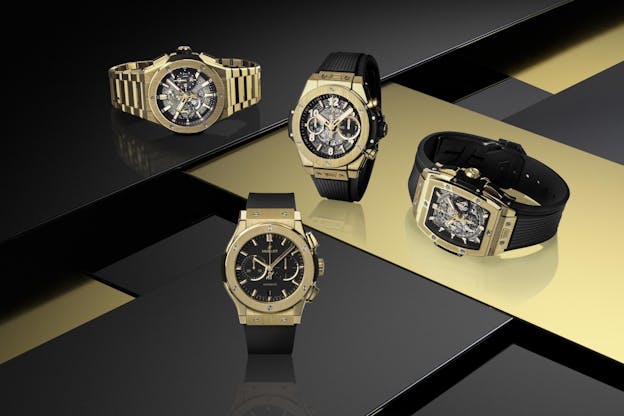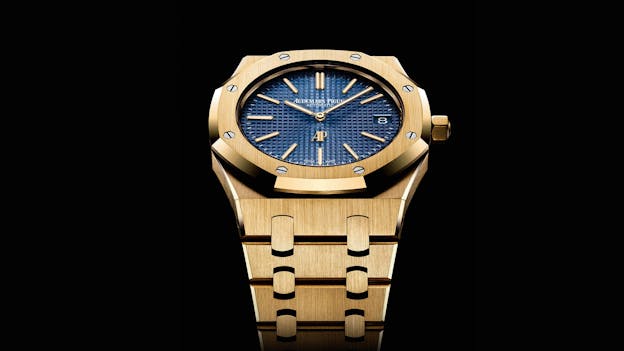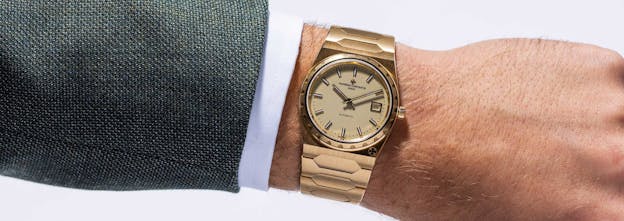Yellow Gold, Once Passé, Is Now The Go-To Gold For Fine Watchmaking
How Yellow Gold Watches Made A Comeback
At the end of 2023, the New York Times ran a story by veteran watch journalist Roberta Naas on the yellow gold trend in fine watchmaking. This trend has a number of poster children, including new releases over the last couple of years from Rolex, Tudor, Bulgari, Audemars Piguet, Vacheron Constantin and perhaps most visibly, Piaget, whose solid yellow gold reboot of the Piaget Polo ’79 made headlines both for its unapologetic opulence in general and for its use of yellow gold in particular.
Since the late 1990s and for many years into the new century, rose and red gold alloys were the default alloys chosen by watch brands, and in addition to the standard repertoire of white, rose, and yellow gold alloys, a whole host of new alloys under proprietary names emerged – we have, in no particular order, Lange’s Honey Gold, Hublot’s King Gold and Magic Gold, Omega’s Moonshine, Sedna, Canopus, and Bronze Gold, Montblanc’s Lime Gold, and others. For a while it seemed as if any self-respecting luxury watch brand had to have at least one proprietary gold alloy in its stable, and yellow gold – for millennia in general and for centuries in watchmaking in particular, virtually the only game in town – seemed the doddering grandpa of the family.

In August of 2024, however, it seems that the news of the death of yellow gold has been greatly exaggerated. You can hardly call it a trend anymore – for one thing, the return to respectability for the metal has been going on for long enough that it has been pretty firmly re-established as, if not the king of gold alloys, at least a respected ranking member of the court.
What Is Yellow Gold?
Yellow gold has been by far the most common alloy for most of recorded human history – it’s been used for both ornamental and monetary purposes and its value has made it, well, the gold standard as a basis for currency. Yellow gold, like other gold alloys, can come in a variety of purities – 24 karat gold (“karat,” a term referring to the purity of a precious metal alloy, shouldn’t be confused with “carat” which is a unit of weight for precious stones) is pure elemental gold. 18 karat gold is 75% gold, and 14 karat gold, 50%. In yellow gold, the rest of the alloy is usually a combination of copper and silver – both of which are often found in the same ore deposits as gold itself.
Both 14 karat and 18 karat gold have been used in watch cases, although the overwhelming majority of gold-cased watches today use 18k gold – perhaps as a way of offering the highest percentage of gold, although there’s an argument to be made that 14k gold would make more sense from a wear and durability standpoint. Gold is the most malleable of all metals – you can draw it out into wires that are one atom thick – so pure gold is far too soft for jewelry, let alone watch cases. Some amount of alloying is therefore essential.

One possible argument against 14k gold in watch cases, is that while pure gold does not tarnish, the metals with which it is alloyed can oxidize and tarnish over time, which will happen more readily with 14k than 18k gold. This is probably a more important reason than offering more gold for your money since the cost, and therefore value, of the extra gold is relatively negligible.
Why Yellow Gold Watches Became Unpopular
There are several reasons yellow gold fell out of favor with brands and enthusiasts.
First, gold watches in general have been, for a new generation of watch enthusiasts, less intrinsically interesting than stainless steel watches. The stainless steel watch boom in general dovetails with the rise of hype watches, since 2020, virtually all of which are stainless steel models with integrated bracelets. It’s not just hype, though. Steel is often the material of choice for vintage collectors as well – some of the most desirable and collectible vintage watches, from everyone from Rolex to Patek Philippe, have been in stainless steel. This trend has coincided with a general decline in more formal dress codes – business attire is a severely endangered species these days, and a suit with jacket and tie seems as fussy, outmoded, and antiquated as a gold dress watch.
Second, non-traditional gold alloys, especially variations on red and pink gold, are a way for watchmaking brands to distinguish themselves from each other. It’s unlikely we would have so many propriety gold alloys – including, also, variations on white gold alloys – if brands didn’t feel that they drove sales and helped to produce a better sense of a brand’s unique identity.
Third, the rise of interest in less formal steel watches, and in more distinctive gold alloys, has gone hand in hand with the idea that yellow gold is sort of an old man’s metal, at least when it comes to watches. I remember being told many years ago by an industry veteran that, when he was starting out in the watch industry (before the Quartz Crisis) if a businessman was being chauffeured, the guy in the back was wearing a gold watch and the guy up front was wearing a steel one. That gold watch would almost certainly have been yellow gold. Such associations inevitably seemed a little bit – or a lot – fuddy-duddy to a new generation of watch collectors, for whom steel watches represented an inside baseball move showing you were one of the cool kids, not one of the uncool geezers.
How Yellow Gold Watches Staged A Comeback
The steel watch trend, and the vintage steel watch trend, was then; this is now, and the pendulum has swung back towards yellow gold once again. The reasons, interestingly enough, are not that far off from the reasons that stainless steel became popular.

Stainless steel, which in 2014 and through 2015 was still something of an insider’s choice, became so popular that it lost some of its luster. The market became flooded, if not with enormous numbers of stainless steel watches (year to year trends are difficult to spot, but from 2015 to 2023, the export value of steel watches, per the FHH, went from CHF 7.6 million to CHF 9.3 million, but you have to bear in mind this is against a 40% drop in number of steel watches exported) then at least, with an enormous amount of chatter on the subject.
Luxury thrives on exclusivity, and once everyone and their brother and sister and the cat and the dog are talking about how much they’d love a stainless steel tool watch, collectors – especially repeat collectors, who would really like to not see themselves lumped in, either in the community’s mind or their own, with the newbies – start to look for something to set them apart. A yellow gold watch is in short, the anti-hype watch, at least in the context of the best known hype watches – and, if it’s a design based on a well respected, but also insider’s vintage model, priced to require real commitment to obtain, and limited enough in production that having one speaks not only to your budget but also to the degree of access you’ve got, and you’ve got something more or less irresistible.
Why yellow gold specifically? The connection of yellow gold to classic vintage watch design had a lot to do with it. This connection was at first part of the reason yellow gold fell out of favor – but that connection came to be seen, in recent years, as a badge of authenticity. And as the watch industry, and collectors, rediscover the larger world of watchmaking from the 1970s, yellow gold has been rediscovered as well. For a generation of collectors that grew up with rose gold as the most common gold alloy in watchmaking, yellow gold is also a refreshing change of pace.

Of course, not every yellow gold watch is exclusive only thanks to price and limited production. There are still any number of very distinguished yellow gold watches – especially pre-owned and vintage – which represent incredible pieces of craftsmanship and history (the first version of the legendary Lange 1 is an excellent example).
Non-yellow gold watches still make up the majority of luxury watches – the 2024 bracelet version of the Patek Golden Ellipse may be, purely on aesthetics, the most stunning watch of the year so far, and it’s rose gold, which just goes to show you that yellow gold in and of itself is not necessary for a watch to be a hot watch. What the trend does mean, though, is that yellow gold is no longer out of bounds by default. Plus, as anyone watching the watch trends knows, geezer watches are in, and if there’s a geezer watch gold alloy, it’s yellow all the way. It’s a gold alloy which represents another perfectly valid, and, thanks to its recovery from relative obscurity, downright cool choice.

